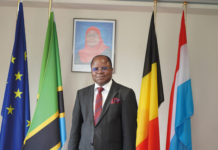After the years of the recession, Namibia is demonstrating serious signs of optimism. Guided by its plan “Vision 2030”, which defines its development objectives, the government is accelerating reforms regarding investments and promoting more and more public-private partnerships.
With the strategic port of Walvis Bay, 65,000 km of roads and 2,380 km de railways, transport and communication are never an obstacle
The country has not fallen short of its nickname “world of opportunities” – since its
independence in 1990, Namibia has been one of the richest and most politically stable countries in Africa. The wealth and variety of its subsoil, coupled with policies encouraging a liberal economy, have made it one of the favorites of the IDE mining sector. Next to  copper, zinc and silver, the production of diamonds is by far what nourishes its GDP most (40%), of which the country is about to become the third largest producer worldwide.
copper, zinc and silver, the production of diamonds is by far what nourishes its GDP most (40%), of which the country is about to become the third largest producer worldwide.
Boosted by massive public spending and the opening of new mines, the Namibian economy experienced several years of strong growth (5.6% on annual average between 2010 and 2015) until 2015, which marked the start of a recession period. But if this relatively bad chapter of the Namibian economy was able to divert the interest investors for a moment, it seems that is coming to an end. The services of IMF forcast a recovery of growth starting this year, that would have to likewise strengthen itself to reach around 3% in the long run. Concurrently, after a decade of constant decline, Namibia pulled itself up to 106th rank in the 190 countries listed in the World Bank’s “Doing Business 2018” report.
“Vision 2030” – For the Benefit of Foreign Investors
Despite its wealth, Namibia is often regarded as one of the least egalitarian societies in the world, as a result of the apartheid. The majority of its GDP is controll ed by the white minority, which makes up 6% of the population. Therefore, the reduction of social disparities and the improvement of the population’s standard of living appear in the national plan “Vision 2030.” To advance towards this ideal, the government has agreed to stimulate economic growth and employment while attracting private and foreign investors.
Firmly in favor of free enterprise since the country’s independence, the Namibian government offers foreigners the possibility to invest in nearly all business sectors, ensuring equal treatment between foreign investors and Namibian businesses which are  regulated by the 1990 law pertaining to foreign direct investments (FDI). The same law guarantees a just compensation in case of expropriation, an international arbitrage in case of conflict between the investor and the government, as well as access to foreign currency. Today, Namibia hopes to attract even more investors. Reforms are underway.
regulated by the 1990 law pertaining to foreign direct investments (FDI). The same law guarantees a just compensation in case of expropriation, an international arbitrage in case of conflict between the investor and the government, as well as access to foreign currency. Today, Namibia hopes to attract even more investors. Reforms are underway.
Creating a Business Will Be easy
As a part of the committed reforms, they took a swing at creating businesses, a process known to be one of the principal obstacles of investment. The laborious applications are comprised of multiple steps, can last for 66 days, and are not always well monitored. The minister of commerce and industry, responsible for foreign investments, has taken up modernizing, shortening, and simplifying this process via the creation of a unique portal: the BIPA (Business and Intellectual Property Authority). Creating a business online should not exceed 48 hours.
Did someone say growth? Namibia’s exit from the famous black list of tax havens last November opened new perspective funds from
European institutions
A single portal, a single gateway. Henceforth, one address: the portal NamBizOne, newly launched to make investors’ lives easier. Long awaited, it assembles all the information and necessary points of contact for local and foreign candidates of investment. Determined in 2019 to evolve the range of e-services provided, it will soon be fully operational for delivering licenses and permits.

Public-private Partnerships: A Key to Development
In the past few years, the Namibian public debt increased considerably, reaching 42% in 2018. To the growth of the indebtment, the President Hage Geingob adopted a series of measures designed to strengthen the national economy. Some of these measures could limit investment possibilities for foreign groups and reinforce the control of the State in some areas, primarily in the natural resources field. Nonetheless, this plan aims most of all to promote public-private partnerships (PPP) and local and foreign businesses.
Being still limited in numbers in the Namibian territory, the PPPs are far spread out in the energy, mining, desalination, and telecommunications sectors or still planned. Tipeeg, a national program for employment and economic growth. For the President Hage Geingob, this type of partnership is one of the indispensable keys Namibian development in reaching its seeking 2030 social objectives. Enthusiasts take note: keep an eye on NamBizOne – the PPP opportunities are expected to multiply in the next ten years!
NamBizOne:
www.doingbusinessnamibia.com
![[:fr]shutterstock_421198501[:]](http://perspectives-cblacp.eu/wp-content/uploads/2019/03/shutterstock_421198501-696x465.jpg)



